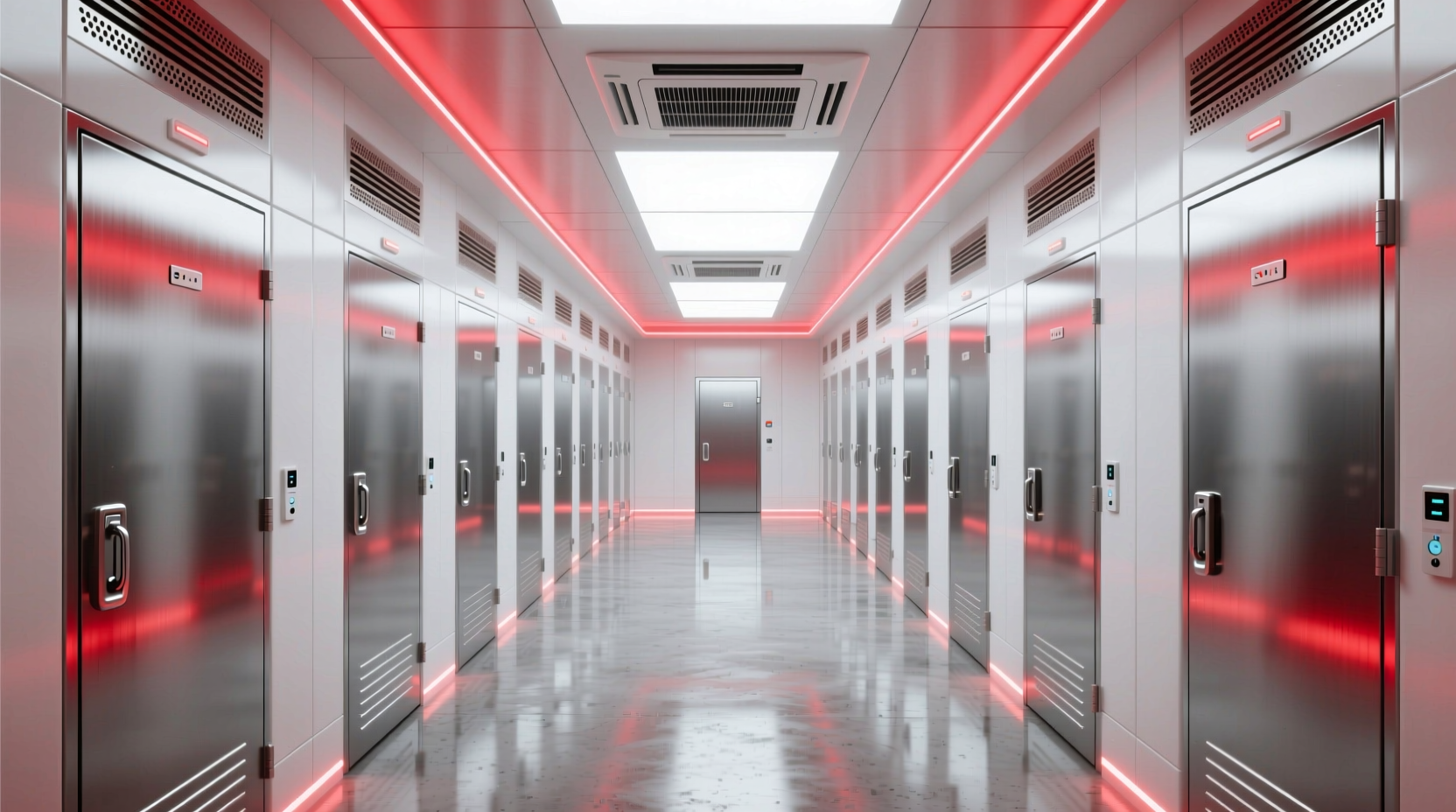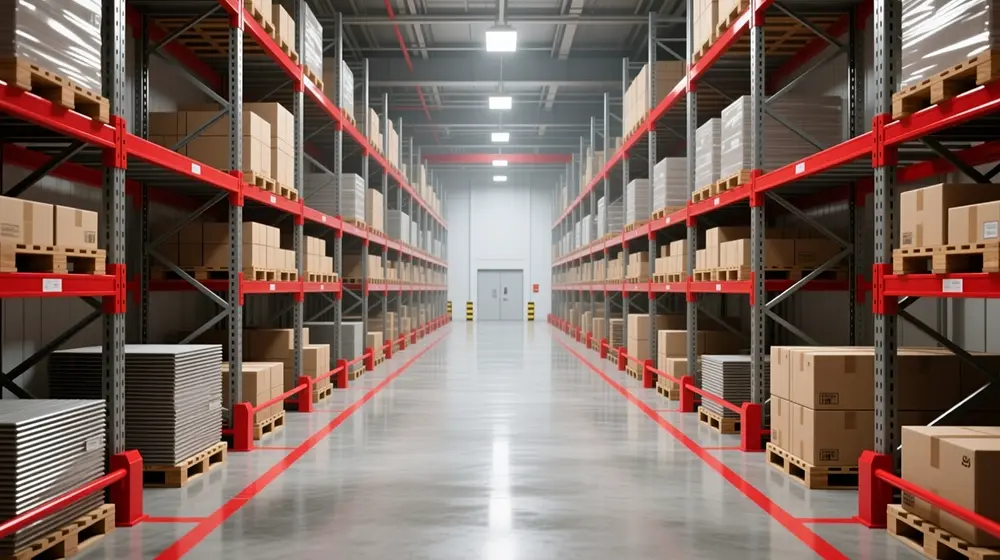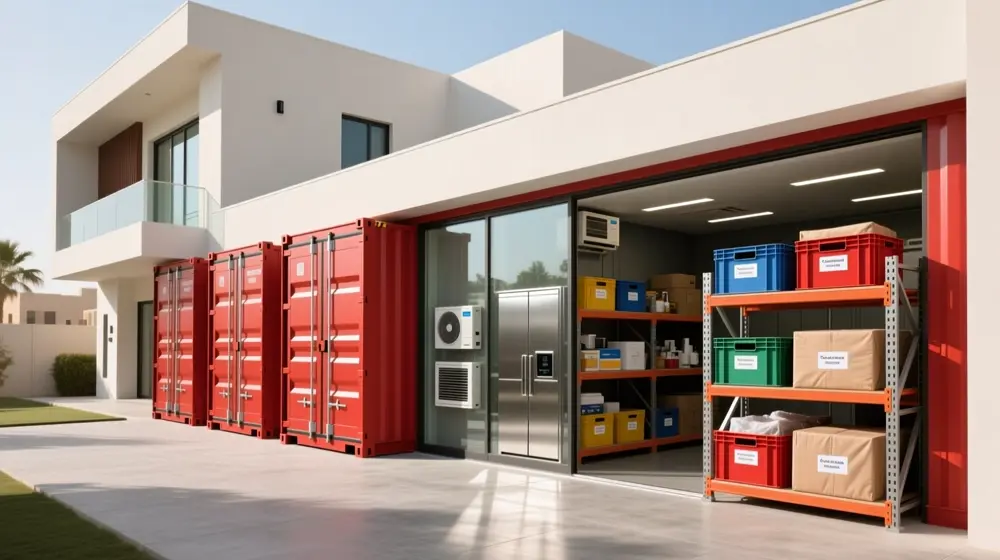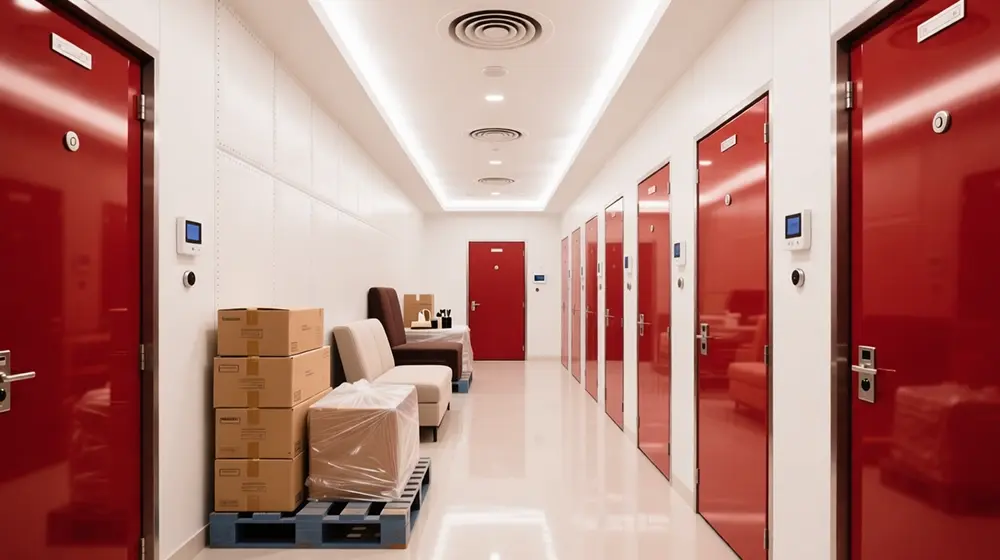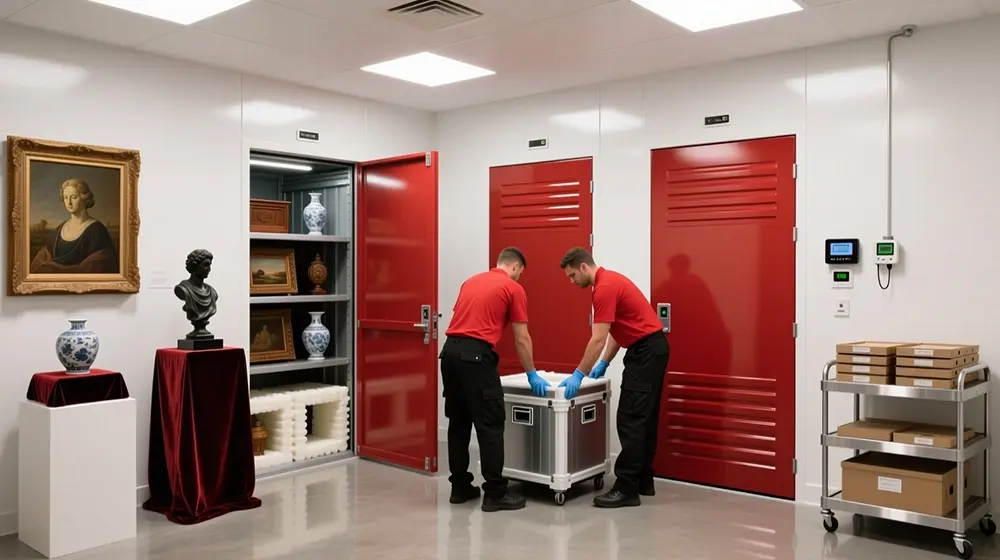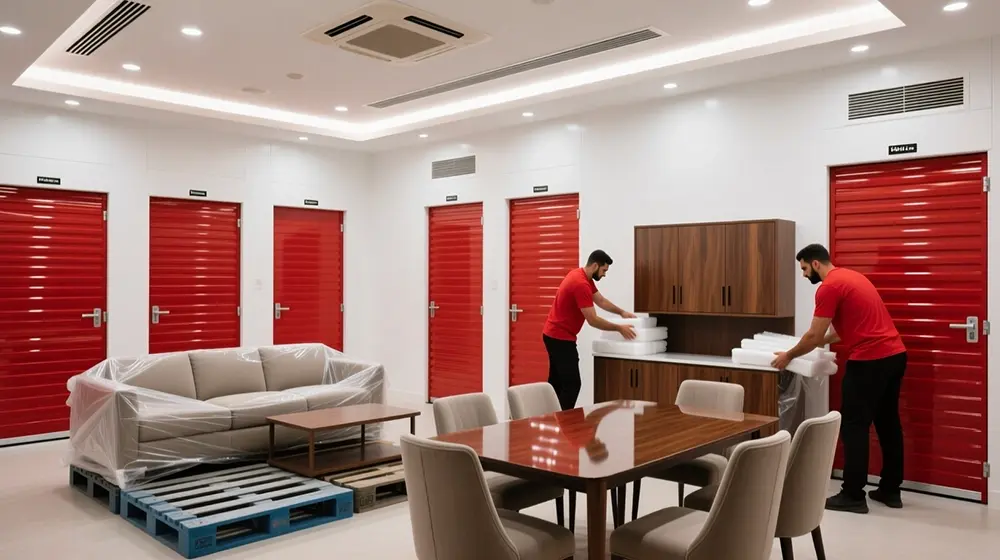UAE Self-Storage Market at a Glance
The self-storage industry in the UAE is entering a phase of accelerated growth, buoyed by shifting lifestyle patterns, rising e-commerce demand, and strong macroeconomic momentum. According to Grand View Research, the UAE self-storage market generated USD 602.5 million in revenue in 2024, and is forecast to reach USD 859.2 million by 2030, growing at a compound annual growth rate (CAGR) of approximately 6.3% over 2025-2030.
Also Read : Why Self Storage in Dubai Is a Smart Choice During a Move
Globally, the self-storage sector is similarly expanding. In 2023, the market size was estimated at USD 56.81 billion, with projections placing it at USD 83.20 billion by 2030, reflecting a global CAGR of 5.9%.
These strong forecasts are underpinned by several UAE-specific tailwinds:
- Non-oil sector growth: During the first nine months of 2023, non-oil GDP surged by 5.9%, contributing around 74% of the country’s total GDP. Sectors like transport & storage, construction, financial services, and tourism are major drivers.
- Diversifying trade and commerce: The UAE’s non-oil trade in goods reached 3 trillion dirhams (~USD 817 billion) in 2024—a 14.6% year-on-year increase—reflecting how trade expansion is supporting business and storage demand.
With this backdrop, the UAE self-storage market is not just scaling in size—it is also evolving in format, service offerings, and customer segments. In this post, we map out the operator landscape, the formats in use, demand hotspots, pricing logic, regulatory constraints, and areas of opportunity (“white space”) that are still underserved.
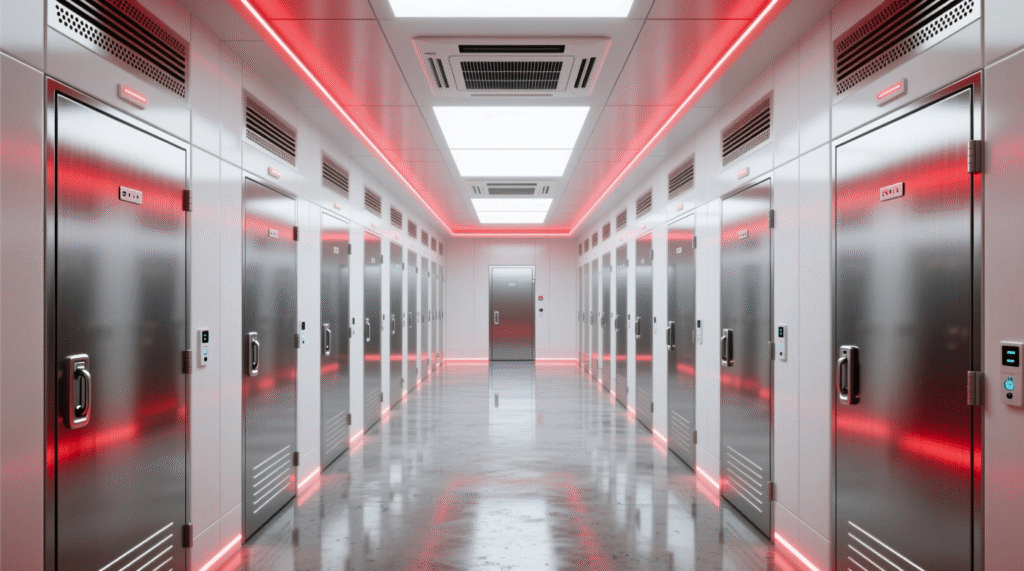
Operator landscape (who’s in the market)
Below are key players in the UAE self-storage market, with added detail for ESelf Storage UAE based on its own disclosures. This helps illustrate how providers vary in format, spec, and service.
Illustrative Brands
- ESelf Storage UAE
- Offers secure, flexible self-storage across multiple emirates, with active facilities in Dubai and Ajman, plus service availability in many other emirates (Abu Dhabi, Al Ain, etc.).
- Provides climate-controlled (air-conditioned) units to protect furniture, electronics, documents, and other sensitive items.
- Access features: 24/7 security & surveillance (CCTV), secure access controls.
- Storage types: personal, business/commercial, furniture, luggage, appliances, villa furniture, warehouse/box storage, and even vehicle/yacht in some cases.
- Flexible plans: short-term and long-term rentals; special offers (e.g., deals for annual commitments) and box/space size choice.
- Delight Self Storage
- Ruby Self Storage
- Offers fully AC (air-conditioned) units in Dubai.
- They provide 24/7 security / CCTV.
- Their services tie in with Ruby Movers, enabling storage + moving services integration.
- The Box
- Premium multi-site operator (JLT, Al Quoz, DIP etc.), climate-controlled units, 24/7 access, also removals, packing materials, e-commerce fulfilment, etc. The Box Self Storage
- Premium multi-site operator (JLT, Al Quoz, DIP etc.), climate-controlled units, 24/7 access, also removals, packing materials, e-commerce fulfilment, etc. The Box Self Storage
- Boxit Storage
- Known for valet/on-demand models across UAE/KSA/Kuwait; item/box-based plans; customers contact via WhatsApp among other channels.
- StorageME (Abu Dhabi)
- Range of unit sizes, lockers to larger; targeted at capital city clients; online presence/catalogue.
How ESelf Storage Differentiates
Based on the available data, here are some of the differentiators for ESelf Storage compared to others:
Also Read : Why Self Storage in Dubai Is a Smart Choice During a Move
Format Taxonomy: What’s on Offer in the UAE Self-Storage Market
The UAE self-storage market is not a one-size-fits-all industry. Operators have diversified their offerings to meet the needs of apartment residents, villa owners, SMEs, and even e-commerce brands. To understand the competitive landscape, it’s helpful to look at two main dimensions: physical product types (what you actually rent) and service wraps (what level of convenience and add-ons are included).
Physical Product Types
1. Lockers & Micro-Units (≈ 0.5 – 1.5 m²)
Perfect for passports, documents, collectibles, and other small personal items. While not every UAE operator advertises lockers as a separate category, box-based storage models from providers like Boxit replicate the concept — you only pay for what you store. These are particularly popular among apartment dwellers who lack built-in storage space.
2. Small & Medium Units (≈ 2 – 10 m²)
This is the core revenue driver of the UAE market. According to Grand View Research, medium-sized units generated the highest revenue share in 2024, reflecting strong demand from apartment movers, seasonal storage users, and short-term relocations. These units are commonly used for furniture, clothes, appliances, and boxes during moves or renovations.
3. Large Units (10 – 30 m² and above)
The fastest-growing segment of the UAE self-storage market. Growth is fueled by villa relocations, SME inventory storage, event equipment, and even contractor tools. Grand View Research forecasts that large units will outpace other segments in CAGR between 2025–2030, making them a lucrative focus area for operators targeting business and premium residential users.
4. Containerised & Modular Storage
While less common in central Dubai, containerised storage offers a capex-light model for industrial zones and suburbs. These 20- or 40-foot containers are especially suitable for SMEs looking for low-cost, flexible storage for pallets, raw materials, or seasonal stock.
5. Specialised Storage Rooms
Premium operators like ESelf Storage and The Box offer climate-controlled rooms to protect furniture, electronics, documents, and artwork from the UAE’s high temperatures and humidity. Some facilities also provide vehicle, boat, or yacht storage, a niche but growing need among expatriates.
B) Service Wraps
Beyond the physical space, operators are competing on convenience, flexibility, and value-added services.
1. Traditional Self-Storage
The classic model: customers transport goods themselves, rent a unit by the month or year, and access it as needed. This is the most affordable format and remains the backbone of the market.
2. Valet / On-Demand Storage
A growing trend led by Boxit Storage, which picks up items from the customer’s location, stores them securely, and delivers them back on request. This model is perfect for residents without transport, busy professionals, or businesses that want a hands-off experience.
3. Business & Commercial Services
Premium providers such as The Box and ESelf Storage are adding enterprise-focused services: receiving deliveries, providing inventory counts, offering light pick/pack operations, and supporting e-commerce fulfilment. This “pre-3PL” model is ideal for small businesses that have outgrown home storage but aren’t ready for a full logistics warehouse.
4. Flexible Leasing & Pay-Per-Box Plans
Short-term rentals, pay-for-space pricing, and promotional packages (such as “first month free” offers) are increasingly common. This flexibility makes storage accessible to students, expats between apartments, and seasonal users.
5. Digital Booking & Access
Operators are also competing on user experience. Online booking, real-time unit availability, WhatsApp quoting, and app-based gate access are becoming standard. This not only attracts younger, tech-savvy customers but also improves operational efficiency.
Key Insight
The combination of physical variety and service innovation is what makes the UAE self-storage market dynamic. Medium units dominate revenues, large units are the fastest-growing, and service layers like valet storage and business add-ons are where operators can differentiate and justify premium pricing.
Demand Hotspots & Use-Cases
The UAE self-storage market’s demand stems from a combination of residential, commercial, and event-based use-cases. Below are regions, customer types, and trends backed by data or credible market indicators.
Verified Drivers & Data
- E-commerce & fulfillment growth: The UAE e-commerce fulfillment services market was valued at USD 2,374.8 million in 2024, and is expected to reach USD 4,645.1 million by 2030, with a strong CAGR of ~11.9%. This reflects rising inventory storage, last-mile logistics demand, and buffer stock needs.
- E-commerce market size and growth: According to IMARC Group, the UAE e-commerce market reached USD 125.0 billion in 2024, and is forecasted to hit USD 776.2 billion by 2033 (CAGR ~21.4% for 2025-2033). That spells accelerating demand overall, which indirectly supports storage needs for both individuals and SMEs.
- Non-oil trade expansion: UAE’s non-oil trade in goods reached 3 trillion AED (~USD 817 billion) in 2024, up 14.6% year-on-year. A growing trade eco-system increases logistics, import/export buffering, and thus demand for storage and warehousing.
Demand Hotspots & Use-Case Patterns
Here are specific types of demand and geographies where storage is especially in demand, along with supporting data or examples:
A) Consumer-Driven Demand
- Move / Renovate / Right-Sizing Cycles
Large residential turnover and high rates of leasing (especially among expats) generate demand for temporary storage during moves or home renovations. Operators like The Box explicitly market their facilities as “just around the corner / convenient locations near key residential & business areas.” This suggests that people in dense corridors prefer accessible storage during transitions. - Dense Residential Corridors (Dubai Marina, JLT, JVC, Business Bay; Abu Dhabi’s Reem / Al Raha)
While explicit data on which neighborhoods produce the most storage demand is limited, many storage providers list these areas in their marketing materials or service area lists (e.g. Public Storage Dubai cites “Dubai Marina” among their convenient locations). - Seasonal Swaps / Short-Term Use
Climatic extremes in UAE drive some customers to store furniture or summer/winter gear seasonally. While there’s less quantified public data, these trends come up in operator descriptions (“protect from the heat”) and mentions of units suited for “household contents / furniture / seasonal items.” For example, Public Storage describes climate-controlled units to protect valuables from Dubai’s heat.
B) SME & Enterprise Demand
- E-commerce Buffer Stock & Fulfillment Needs
As noted, the large growth in the e-commerce market (size, volume) and fulfillment services signals that many SMEs need storage for inventory, returns, packaging, and delivery staging. The UAE E-commerce Fulfillment Services Market report shows the scale and forecast of demand. - Events & Exhibitions
Dubai hosts many large exhibitions and trade shows. While I could not find a public source quantifying how much storage is used specifically “between shows,” freight partners and venue manuals typically refer buyers to temporary storage options. Storage operators and moving companies around DWTC often include services for exhibitors. (Implied, though I’d need event-venue documentation for exact numbers.) - Office / Contractors (Archives, Tools, Spares)
Businesses (offices, contractors, professionals) need to store records, tools, spare parts, and other overflow materials. Some self-storage providers explicitly offer business storage units with flexible access and loading-bay support (e.g. Public Storage Dubai). Ruby Movers also offers storage solutions services.
Example: Ruby Movers & Storage Solutions
- Ruby Movers UAE advertises doorstep self-storage services for short-term and long-term use, with flexible and secure storage options aimed at both domestic and business customers. This indicates demand from people who want both convenience (moving + storage) and flexibility in contract duration.
Note: This is a table
Summary of Demand Hotspots
| Demand Type | Key Drivers | Key Hotspot Areas / Customer Profile |
| High residential mobility & right-sizing | Leasing, renovations, apartment turnovers | Dense residential zones like Dubai Marina, JLT, Business Bay; Reem / Al Raha in Abu Dhabi |
| E-commerce / SMEs | Fulfillment, buffer inventory, returns | Businesses near logistics hubs; suburbs where warehouse space is cheaper |
| Events & Exhibitions | Trade shows, pop-ups, seasonal usage | Areas around DWTC, Expo, major convention centres |
| Office surplus / contractor tools | Need for secure access, loading/unloading, flexible lease | Business districts, industrial zones, contractor hubs |
Site Selection Patterns: How Self-Storage Facilities Choose Locations
Choosing the right location for a self-storage facility in the UAE is not just about finding an empty warehouse — it requires balancing catchment accessibility, regulatory compliance, and safety considerations.
Catchment & Road Access:
Operators typically look for sites near dense residential clusters and key arterial roads such as Sheikh Zayed Road (SZR), Al Khail Road, and E311/E611, ensuring customers can reach the facility easily. Popular storage corridors include Al Quoz, Dubai Investment Park (DIP), and Jumeirah Lake Towers (JLT) — all highlighted by premium operators like The Box for their proximity to urban populations and business districts
Fire & Life Safety Compliance:
Every facility must meet the Dubai Building Code (DBC) and the UAE Fire & Life Safety Code of Practice, which specify structural safety, fire detection systems, sprinklers, alarms, emergency exits, and clear egress routes (Dubai Municipality DBC; UAE Fire Code). These requirements often influence site choice, as not all older buildings can be economically retrofitted to comply with these standards.
Dangerous Goods & Compliance:
Facilities must also align with the Code of Practice for the Management of Dangerous Goods in the Emirate of Dubai, which regulates how hazardous substances (e.g., flammables, corrosives, lithium batteries) can be stored or handled. Many self-storage companies mitigate compliance risk by publishing a prohibited items list and restricting access for such goods, unless dedicated DG-approved areas are in place.
Also Read : Is Self Storage in Dubai Sustainable? Exploring the Environmental and Economic Benefits
The result is a site-selection process that balances customer convenience with regulatory readiness. Facilities in well-connected urban corridors that are fire-code compliant and DG-safe not only attract more customers but also reduce operational risk, insurance costs, and approval delays.

Pricing Logic: How Operators Set Rates
Understanding how storage operators price their units in the UAE reveals useful levers for differentiation and profit. Several confirmed trends guide pricing strategy:
Size Laddering & Unit-Segment Revenue Dynamics
- According to Grand View Research, the medium-sized unit segment generated the largest share of revenue in the UAE self-storage market in 2024. Meanwhile, large units are forecast to be the fastest-growing segment from 2025 to 2030.
- This pattern supports tiered pricing: smaller units carry higher per-square-meter rates, and as unit size increases, the rate per m² typically drops—making larger units attractive for customers who can pay for more space and giving operators opportunities to upsell. (In general storage market behavior per unit size discussed in MEA / UAE report.)
Specification Premiums (Climate Control etc.)
- Climate-controlled units — those that manage temperature, humidity, and protection from the elements — command higher costs. ESelf Storage’s “Unit Economics of Climate-Controlled Self-Storage in Dubai” estimates that warehouse lease rates for temperature-protected space run about AED 30–60 per sq ft/year, before factoring in utilities, staffing, and maintenance.
- Premium operators like The Box Self Storage heavily market climate-controlled rooms with 24/7 access, using this specification as a differentiator in both positioning and pricing.
Valet / On-Demand & Per-Item / Box-Based Pricing
- Boxit Storage UAE publishes rates based on items/boxes or approximate apartment sizes. For example, their site lists average monthly pricing for “Studio / 1 Bed apt.” ~ AED 750, “2 Bed apt.” ~ AED 2,080; picking up and returning items is optional and priced separately.
- Their model includes a “pay-as-you-go” philosophy: customers are billed monthly and can cancel at any time. This flexibility allows per-item or per-box rate structures, as well as premium charges for pickup/delivery services.
Term Incentives & Bundled Add-Ons
- Long-term contract incentives (e.g. 3-, 6-, 12-month deals) are common in the UAE market. Providers offer promotions and lower effective monthly rates for longer stays. While specific universal terms are not always publicly disclosed, the marketing language of many operators (The Box, ESelf) refers to special offers for annual plans or longer commitment periods.
- Bundled services such as locks, shelving, insurance, removal/packing supplies are often included or offered at discounted rate with longer leases. These add-ons help increase average revenue per customer and reduce friction in upselling. (Though exact bundles differ by provider.)
Key Takeaways
- Medium units drive revenue today; large units are growing fastest — pricing structures should reflect both the current demand and forecast growth.
- Climate control remains a premium feature customers are willing to pay extra for — with significant OPEX implications for operators.
- Valet/on-demand and item-oriented pricing models add convenience, but also require clear separation of service charges (pickup/delivery etc.).
- Term-based incentives and bundles are effective tools to lock in longer revenue streams and differentiate offerings.
Regulations & “What You Can’t Store” (Must-Know)
Storage operators in the UAE must comply with several laws and regulations governing building safety, dangerous goods, and civil defence. These rules also shape what items are prohibited in self-storage facilities.
- Dangerous Goods Regulation (Dubai)
The Code of Practice for the Management of Dangerous Goods in the Emirate of Dubai (WKC Group 2023) mandates that explosives, fireworks, detonators, and ammunition are strictly prohibited in general warehouses or storage facilities. Classes 2-8 dangerous goods (flammable, corrosive, toxic gases etc.) are regulated and require special licensing or storage provisions. - “What You Cannot Store” – ESelf Storage Guidance
ESelf Storage UAE Storage Guidance confirms that items like explosives, fireworks, detonators, ammunition, and other hazardous materials are unauthorized and a criminal offence to store in general warehouses/self-storage facilities. - Environmental & Permit Requirements for Storage of Dangerous Goods
Under Dubai Municipality guidelines (Environmental Clearance / Development & Infrastructure), any premises storing dangerous goods must apply for permits through the EPSS (Environmental Permits & Surveillance Section), and comply with packaging, labeling, and handling requirements. - Building Design & Life Safety
While not all self-storage operators explicitly publish “building code compliance” for every facility, Dubai’s unified Building Code sets fire resistance, means of egress, mechanical/electrical/plumbing (MEP), accessibility, and other safety criteria that any new build or retrofit (for storage) must meet. (Implicit regulation under Dubai Municipality / Civil Defence; specific text is part of Dubai Building Code and related documents). Note: I did not find a public link that shows self-storage operators listing their building code compliance line-by-line, but it is a regulatory requirement. - Prohibited Items – Operator Policies
Many UAE self-storage providers publicly list prohibited items consistent with the dangerous goods law: fireworks, gas cylinders, explosives, etc. ESelf’s regulations page is a good example.
The Current Market Map
This part describes differences in supply, product variety, and market maturity across the UAE’s emirates, supported by available information or inferences.
- Dubai
Dubai has the highest operator density and widest product variety, including traditional self-storage, valet services, climate-controlled rooms, boxes/lockers, and business storage. The Box Self Storage is among premium operators in Dubai that market broad service offerings. Demand is high in districts like JLT, Marina, Business Bay. (While I did not find a citation that explicitly lists all these offerings by each operator in Dubai, multiple operator sites show diverse services in Dubai.) - Abu Dhabi
Abu Dhabi has an increasing number of self-storage operators. For example, StorageME operates in Abu Dhabi with online unit catalogues and business/commercial storage options. This suggests room for growth in higher-spec climate control and business-oriented storage services. Note: Direct data for Abu Dhabi in terms of number of operators vs product variety is smaller in public sources than for Dubai. - Sharjah / Ajman
Value-oriented catchments appear to be growing in Sharjah and Ajman. Delight Self Storage, for instance, lists “Personal Storage in Sharjah and Ajman” among its locations. Because costs (land, rent) tend to be lower outside core Dubai, these emirates are likely where containerised or hybrid formats (less premium, more basic) could compete more successfully. However, I did not find a strong public source (e.g., Reuters or government data) that quantifies the number or growth rate of self-storage operators in Sharjah / Ajman vs Dubai or Abu Dhabi, only that these regions are included in ‘storage coverage’ by providers.
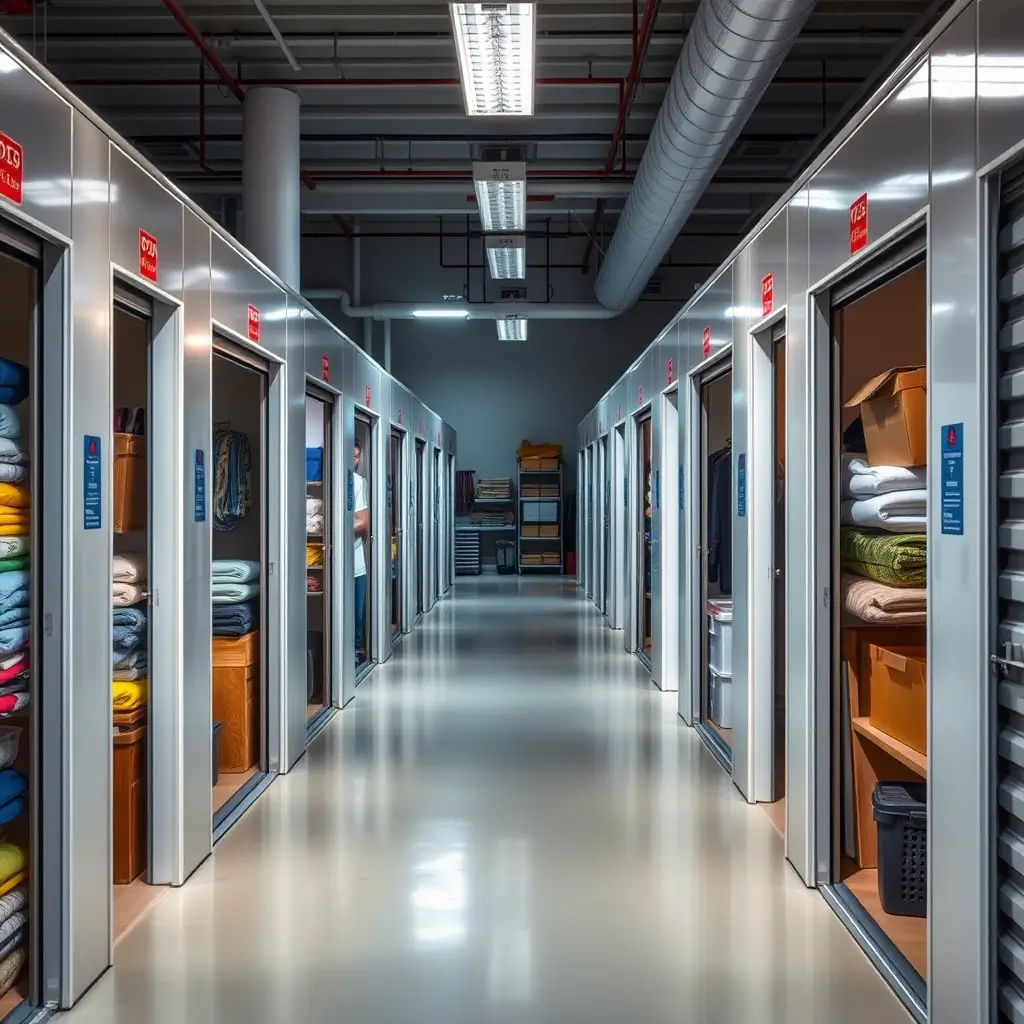
Five White-Space Opportunities (Tested Playbooks)
As the UAE self-storage market matures, several under-served niches are emerging. These “white-space” opportunities offer pathways for operators to differentiate, capture new customer segments, and increase yield.
- SME-First “Flex Storage + Light Fulfilment”
Many e-commerce brands in the UAE still require storage space for buffer inventory, returns, packaging, or staging but aren’t yet ready to invest in full 3PL operations. Operators who offer receiving, barcode inventory, light pick-and-pack services, and fast response SLAs (e.g. via WhatsApp or dedicated account managers) can fill this gap. This aligns with global growth in business/self-storage applications. Grand View Research identifies business/personal use cases growing in self-storage globally. - Micro-Urban Lockers Near Metros / High-Rises
There is strong demand from apartment dwellers in dense corridors who lack storage and transport options. Micro-lockers (0.5-2 m²) with app-based access, on-demand retrieval, or small-item drop-offs could be valuable. Though specific UAE data is limited, the growth of medium and large unit revenue suggests demand for smaller, more flexible formats too. - Event & Exhibition “Between-Shows” Contracts
Events, booths, AV equipment, exhibition stands and collateral require temporary storage before, during, and after events. ESelf Storage’s Events & Exhibitions: Short-Term Storage Playbook for Dubai Venues confirms venues like DWTC and Expo City routinely rely on storage providers to support both logistics and staging. Exhibitor manuals (e.g., from Gulf Print Pack) also highlight logistics and storage requirements in event planning. - Premium Climate Portfolios
The UAE’s extreme temperature and humidity mean climate control is a valued feature. Grand View Research data shows that large units are forecast to grow fastest, which often correlates with higher-spec storage (e.g. climate control). Operators who build humidity-managed rooms and ensure premium protection for sensitive goods (electronics, artwork, high-end furniture) can charge premium rates. - Suburban Abu Dhabi & Sharjah Node Network
Outside of core Dubai, real estate costs tend to be lower, but population growth and SME expansion drive demand. Building smaller “satellite” nodes or container/micro-site formats, combined under a unified app or booking system, may offer cost-efficient expansion. This leverages non-oil sector growth and transport/trade logistics trends across the UAE/Sharjah region. Grand View’s MEA data confirms medium and large unit growth in the UAE and surrounding emirates.

Go-to-Market Checklist
To successfully execute on these white-space plays, here are key strategic and operational levers with supporting evidence:
- SKU Grid Design:
Structure offerings by Size (Small / Medium / Large) × Climate Control (Yes / No) × Access Hours (24/7 vs Business Hours). Use the 12-month plan as anchor pricing, with discounts for 3- and 6-month terms. Data from Grand View Research supports that medium units currently lead in revenue share while large units are growing fastest—making a differentiated SKU strategy important. - Digital Customer Experience (CX):
Real-time unit availability, instant online booking, digital contracts, and WhatsApp or live chat support are increasingly expected. Operators like ESelf and Boxit already offer these features. Strong online UX helps in high competition markets. (Examples of playbooks in event storage guides show event organizers expect fast, flexible service with short-term storage options. ESelf’s event storage playbook confirms this. - Acquisition Channels:
Use “self storage near me” map listings, Google Local Services, partnerships with relocation companies, property managers, and event suppliers (AV, exhibitions). DWTC’s exhibitor services and exhibitor manuals show that event organisers look for storage and logistics partners in their vendor listings. - Operational Discipline & Compliance:
Publish prohibited items clear lists; conform to Dubai Building Code and dangerous goods/chemical regulations; standardise loading-bay / NOC / safety checklists especially when dealing with events, business customers, or high traffic. Many DWTC exhibitor manuals require logistics contractors to submit plans ahead of events, follow safety regulations.
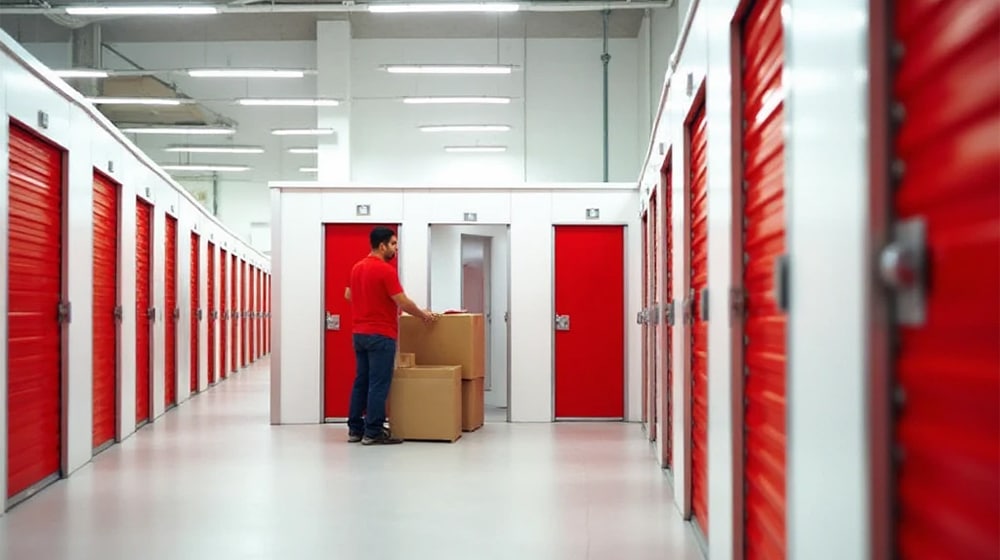
Outlook (2025-2030)
Looking forward, the UAE self-storage market is expected to maintain strong growth. Grand View Research forecasts a CAGR of ~6.3% from 2025 to 2030, with market size increasing from ~USD 602.5 million in 2024 to ~USD 859.2 million by 2030. Medium-sized units currently dominate revenue; large units grow fastest.
Operators who combine spec-right assets (climate control, security, safety systems), with product innovation (valet, micro-lockers, business add-ons) and strong regulatory and operational discipline (compliance, safety, permit/NOC features) are likely to command durable margins. Also, building a hub-and-spoke network (flagship & satellite nodes) can help cover more geography while controlling capex.
